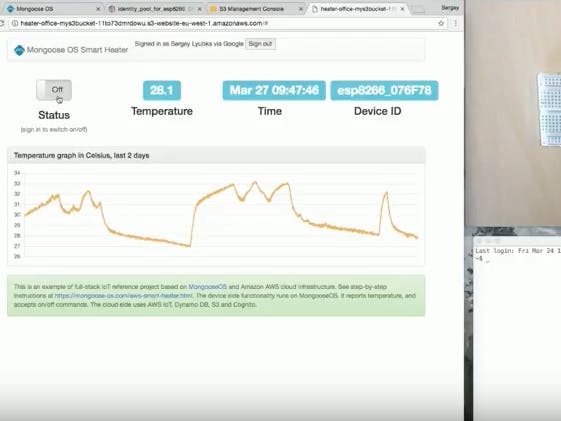- Description: Control heater remotely, see historical stats
- Difficulty: Medium
- Hardware: ESP8266, MCP9808 sensor
- AWS services: AWS IoT (device shadow API), AWS DynamoDB, AWS S3, AWS Cognito
This is a "Smart Heater," for example the heater device reports current temperature, responds to the status requests and to the heater on/off command.
Prerequisites
- Hardware: ESP8266 NodeMCU
- Google and/or Facebook account
- Amazon AWS account
- Amazon's
awsmanagement utility (see https://aws.amazon.com/cli)
The data flow is as follows:
- A device uses I2C temperature sensor and sends data to the AWS IoT periodically
- An AWS IoT rule intercepts temperature data and stores it into the DynamoDB table
- A device gets synchronised with its AWS IoT shadow
- A frontend with OAuth is running on AWS S3, talking to the device shadow to either get the device state, or set the device state (turn it on/off)
First of all, you'll need to create Google and/or Facebook OAuth2 Client, so that users will be able to login into the heater application.
For Google: visit Google Cloud Console, click Create credentials -> OAuth client ID -> Web application, and enter some name, e.g. "AWS Heater", and click "Create". It will show your client ID and secret; copy client ID, you'll need it soon. And don't close the tab for now: when your stack is instantiated, you'll need to get back here and enter the Authorized JavaScript origin.
For Facebook: visit Facebook Apps, click "Add a New App", enter some name, like, "My Heater", pick a category, click "Create App ID". When the app creation is done, you'll see the app dashboard. Don't close the tab for now: when your stack is instantiated, you'll need to get back here and enter the Website URL.
Code with Instructionsgit clone https://github.com/cesanta/mongoose-os.git # Clone mongoose-os repo
cd mongoose-os/fw/examples/aws_iot_smart_heater # Go to the example project
mos flash mos-esp8266 # Install Mongoose OS
DEVICE_ID=$(mos config-get device.id) # Get device ID
mos put init.js # Copy init.js on the device
mos config-set aws.shadow.enable=true # Enable AWS IoT shadow API
mos wifi WIFI_SSID WIFI_PASSWORD # Setup WiFi
mos aws-iot-setup --aws-iot-policy=mos-default # Provision on AWS IoT
npm --prefix ../helpers/cloudformation-helpers install ../helpers/cloudformation-helpers
# We'll also need to create a separate S3 bucket for helper functions:
aws s3 mb s3://my-cf-helpers
# Get the endpoint address for your AWS account, you'll need to provide it as
# a parameter for your stack:
AWS_IOT_ENDPOINT=$(aws iot describe-endpoint --output text)
# Now, "package" the template. Packaging includes copying source code of the
# helper functions from local machine to the s3 bucket we created above,
# and adjusting the template appropriately. It's all done in one step:
aws cloudformation package \
--template-file aws_iot_heater_template.yaml \
--s3-bucket my-cf-helpers \
--output-template-file packaged_template.yaml
# Generate Oauth IDs on Google and Facebook
GOOGLE_CLIENT_ID=YOUR_GOOGLE_CLIENT_ID
FACEBOOK_CLIENT_ID=$YOUR_FACEBOOK_CLIENT_ID
STACK_NAME=my-heater
# The command above has created a new template file: packaged-template.yaml.
# Now, instantiate AWS stack using this template. Feel free to choose another
# stack name.
aws cloudformation create-stack \
--stack-name $STACK_NAME \
--parameters \
ParameterKey=DeviceID,ParameterValue=$DEVICE_ID \
ParameterKey=EndpointAddress,ParameterValue=$AWS_IOT_ENDPOINT \
ParameterKey=GoogleClientID,ParameterValue=$GOOGLE_CLIENT_ID \
ParameterKey=FacebookClientID,ParameterValue=$FACEBOOK_CLIENT_ID \
--capabilities CAPABILITY_IAM \
--template-body file://packaged_template.yaml
# Wait until the stack creation is completed (it may take a few minutes).
aws cloudformation wait stack-create-complete --stack-name my-heater
# Alternatively, you can use the web UI to check the status and read event
# details: https://console.aws.amazon.com/cloudformation/home
# When the stack is created, get the name of the created S3 bucket:
aws cloudformation describe-stacks --stack-name $STACK_NAME
# look for the following:
# ...
# {
# "Description": "Name of the newly created S3 bucket",
# "OutputKey": "S3BucketName",
# "OutputValue": "S3_BUCKET_NAME"
# },
# {
# "Description": "URL of the s3 bucket",
# "OutputKey": "S3BucketWebsite",
# "OutputValue": "APP_URL"
# }
# ...
S3_BUCKET_NAME=GENERATED_S3_BUCKET_NAME
APP_URL=GENERATED_APP_URL
# $S3_BUCKET_NAME is the name of the bucket, and $APP_URL is the URL at
# which your files can be accessed.
#
# Copy the actual value of "$APP_URL", and then enter it in the Google and/or
# Facebook app settings: For Google: go back to the Google Console, and add the
# URL as an Authorized JavaScript origin. For Facebook: go back to the app's
# dashboard, click "Settings" in the sidebar, then click "Add Platform" at the
# bottom, select "Website", and enter Site URL.
#
# Then, copy the actual value of "$S3_BUCKET_NAME" (from the describe-stacks
# output), and use it to put two files on the S3 bucket:
aws s3 cp bucket/index.html s3://$S3_BUCKET_NAME --acl public-read
aws s3 cp bucket/index.js s3://$S3_BUCKET_NAME --acl public-read
# Download two files of Cognito SDK, and also put them on the S3 bucket:
curl -O https://raw.githubusercontent.com/aws/amazon-cognito-identity-js/master/dist/aws-cognito-sdk.min.js
curl -O https://raw.githubusercontent.com/aws/amazon-cognito-identity-js/master/dist/amazon-cognito-identity.min.js
aws s3 cp aws-cognito-sdk.min.js s3://$S3_BUCKET_NAME --acl public-read
aws s3 cp amazon-cognito-identity.min.js s3://$S3_BUCKET_NAME --acl public-read
# Now, navigate to the index page of your app $APP_URL.
You'll see latest graph of the temperature reported from the device, current heater status (on/off), and the switch. Switching the heater is possible only for authenticated and authorized users; click "Sign in with Google".
NOTE: if it complains about mismatched redirect URI, just wait a couple of minutes, the settings in Google Console might need some time to take effect.
If you try to switch the heater status, you'll get the message saying that you are not authorized to do that. Now, you need to authorize your user to manage heater.
For that, navigate to the AWS Cognito console, click "Manage Federated Identities", select "identity_pool_for_DEVICE_ID", click "Edit identity pool", expand "Authentication providers", click on the "Google+" tab, and in the section "Authenticated role selection" change "Use default role" to "Choose role with rules". Here, you can use whatever rule you want. For example, in order to authorize some particular user, you can specify Claim: "email", match type: "Equals", value: "addr@domain.com", and pick a role "my-heater-myHeaterAdminRole-XXXXXXXX".
After that, you can sign out from your heater app, sign in back, and switching the heater should result in the state being changed.
ThanksHave fun!
If you like this and find useful, please hit the 'Respect project' button and don't forget to 'Share'. That way we will hear your feedback and bring even more exciting projects to you door.
For a more in-depth introduction, see the Mongoose OS documentation and video tutorials.
Check also other projects by Mongoose OS team.
Questions? Feedback? Reach us via forum.cesanta.com





_gKoW55Hp00.png?auto=compress%2Cformat&w=48&h=48&fit=fill&bg=ffffff)









Comments
Please log in or sign up to comment.